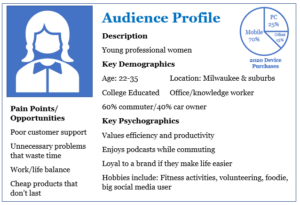
Stripe calculates about 300,000 people will start their creator business in 2022 which means you’ll need a strong strategy if you dream about being a successful creator.
So let’s dive into the ultimate guide for you to start your creator business in 2022 and see more success this year.
When it comes to being a successful creator, it takes more than just working with brands.
Creators ultimately have two “customers” they serve.
The first is their audience. These are the people you connect with through the content you make.
The next customers creators serve are brands.
These are the companies you connect to your audience in order to increase brand awareness and sales.
But before you can dive into serving your customers, you’ll need to establish who those customers are and what your content will be about.
Table of Contents
Establish Your Niche
As a creator, your niche is the category your content falls under.
Common creator niches include
- Business
- Finance
- Lifestyle
- Food
- Sports
- Gaming
- Tech
- Fashion
- Beauty
Your niche is not limited to just these categories, but these are some of the most common.
The more specific you get with your niche, the easier it will be to grow your platform.
This is known as niching down.
For example, instead of just being in the finance niche, you can specifically talk about all things cryptocurrency.
This allows you to establish credibility in your brand, increase discoverability since you aren’t competing with as many other creators, and create consistency within your content.
To find your niche you need to establish your skills and passions that have a demand.
Ex: if you are skilled in woodworking and have a passion for DIY furniture, you can combine this into a niche of DIY woodworking furniture.
But before you commit to this niche, you’ll want to ensure that there is a demand for that niche.
To assess the market demand for your niche, you’ll want to do some competitive research.
You can do this by looking up channels on YouTube, searching for blogs, or searching keywords on Instagram.
This will give you an idea of how many people are interested in this type of content so you can establish the success of the niche before committing to it.
Once you have your niche established, you’ll want to define your target audience.
What is A Target Audience?
Your target audience are a group of people with similar demographics such as their age, location, gender, family status, and income.
You will need to define your target audience is that would be interested in your niche and the type of content that you make.
This can also be done with the same competitive research you did for your niche.
You can also use Audience Analysis tools that allow you to build your audience profile based on their demographics and channels they would be most likely to watch.
From here, you can understand more about the type of content your audience likes to engage with, why they engage with the content, and where they engage so you can choose the platforms to create your content on.
Which Social Media Platform Is Best?
When it comes to choosing where to upload your content to, it can be tempting to want to be on every social media platform. But to grow rapidly, starting with one to two platforms is key.
You’ll want an SEO based platform such as YouTube, Blogs, or Pinterest as one of your main platforms to start on.
SEO platforms are a great way to increase discoverability by dominating popular keywords in your niche.
If you are unaware, keywords are search terms your audience will type into search bars on Google, YouTube, and Pinterest to find the content they are most interested in.
So if you are trying to attract a specific audience, you will want to make content around the specific keywords your target audience is typing into these websites.
You can use keyword research tools like Keywords Everywhere to identify the search volume and competition pool of these keywords.
The key is to find high searched keywords with low competition so you can rank on the first page of search results and get discovered by your audience faster.
The downside to these platforms is the lack of engagement you are able to have with your audience.
A part of being a creator is building a strong audience community. So you’ll want to engage with your audience in more than just your edited videos, Pinterest Pins, or Blog posts.
This is why a secondary platform like Instagram or Twitter is helpful as they allow you to communicate with your audience on a deeper level through stories and DMs.
The more your audience feels they know you, the easier it will be for them to connect to you and the content you make.
Planning Your Content Strategy
The content you make is what attracts both your audience and brands you’ll want to work with.
You’ll want to create a strategy that keeps your content consistent and establishes credibility in your brand.
To do this, you’ll want to focus on 3 key areas of content creation:
- Evergreen content
- Viral Content
- Connection Content
Evergreen content is content that is optimized for search and stays relevant to your audience over a long period of time.
Examples of evergreen content include Guides, Tutorials, and case studies.
Evergreen content typically has a long lifespan making it great for long term growth in your creator business.
Viral content is content that spreads rapidly through your audience.
Examples of viral content include songs, news articles, memes, or even movies.
Viral content has a short lifespan, but is great for a quick boost in growth as a lot of people are interested in this content at the same time.
This boost can last for a few hours to a few weeks before the virality begins to fizzle out.
Last, you’ll want to make content that connects with your audience.
More people are interested in learning about the creator behind the business.
So making content such as a look behind the scenes of your business, story time content, or even Q&A style content will allow your audience to connect with you more.
Connection content is mainly for your established audience and reduces the amount of unfollows you may receive.
So while connection content can be used to grow your channel, this type of content typically keeps those who have already followed you interested in your content.
Creating A Monetization Strategy
The last part of starting your creator business comes down to creating a monetization strategy. Most creators will wait to establish this once they start making money. But if you want to go full time with your creator business, establishing a monetization plan early can help you reach that goal faster.
When it comes to monetizing your creator business, something you need to know is having a large following is not mandatory. There are creators with less than 1,000 followers making money from their content simply because they have a strategy in place.
Part of that is deciding which revenue stream to start with first.
As a content creator, there are multiple ways you can make money, but some of the most common include:
- Ad-sharing
- Crowdfunding
- Affiliate marketing
- Brand Sponsorships
- Freelance Work
You can learn more about each income stream in our last blog post.
Getting familiar with these income streams now makes it easier to incorporate into your monetization strategy later on.
As a creator, you do not want money to be the main purpose of creating content. Building a strong community with your audience should always come first.
But being a part of the creator economy is a business, and for a business to be successful, you must have a plan in place to make money, or this will be one of the most expensive hobby’s you’ve ever started.
In Conclusion
But, when it comes to getting started as a content creator in 2022, the main thing you want to remember is that you must get started.
Do not worry if your niche isn’t perfect, you haven’t defined your audience or you have no clue what content to make now.
Some of the greatest and most successful creators simply got started and figured it out along the way.
But we want to hear from you. Let us know in the comments what some of your creator goals are for 2022.


